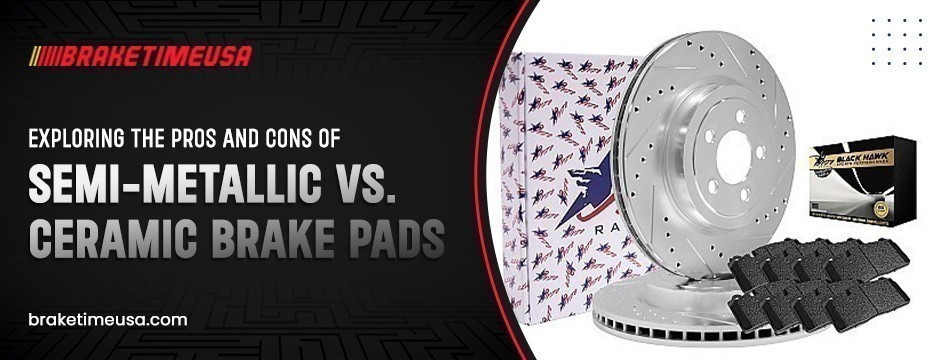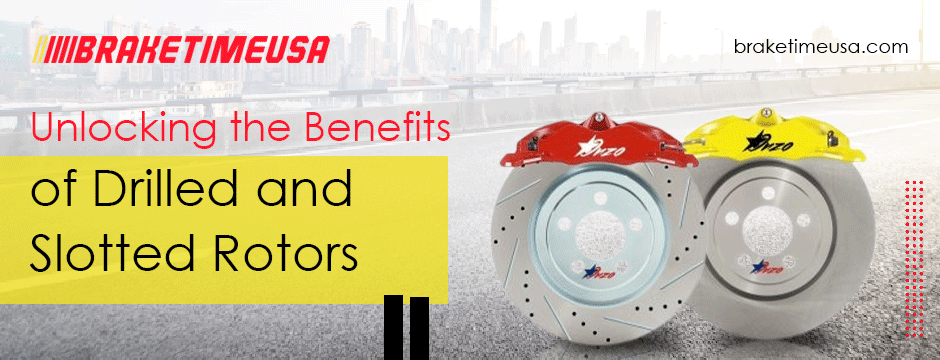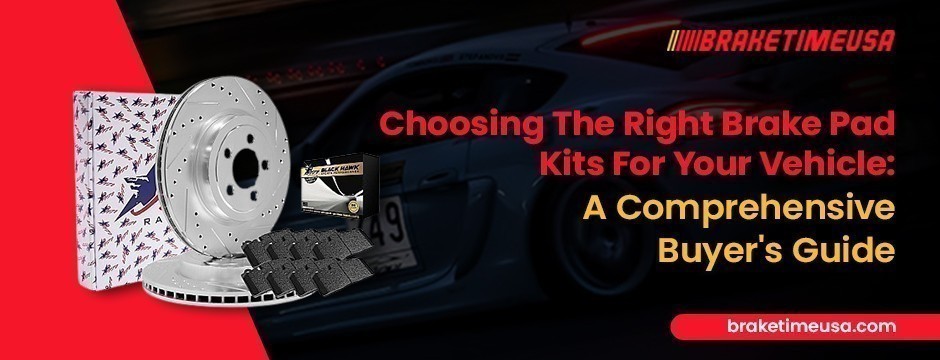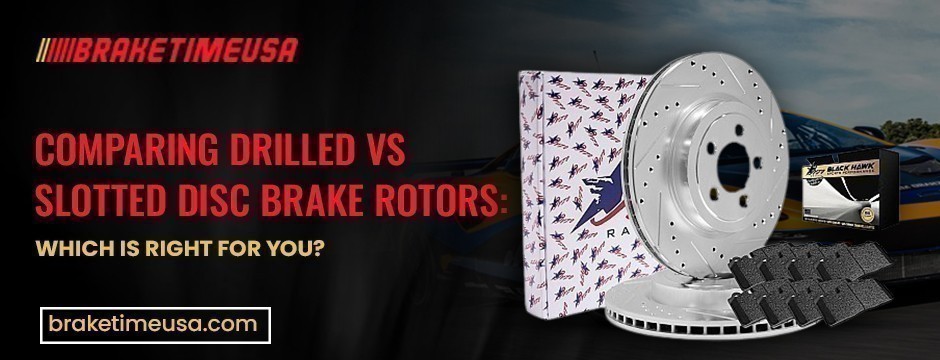Your cart is empty
Subtotal:$0.00
Your vehicle's braking system is not just a convenience but a critical safety feature that ensures you can navigate roads safely. Often overlooked, understanding the intricate workings of this system empowers you to make informed decisions regarding maintenance and potential upgrades. Central to this complex mechanism are brake pads, a seemingly small component with an outsized role in the overall functionality of your brakes. In the following sections, we will explore the differences between organic vs semi metallic vs ceramic brake pads, shedding light on their histories, compositions, and the considerations for determining which is the best fit for your vehicle and driving style.

Before delving into the specifics of brake pads, it's crucial to grasp the fundamental operation of your vehicle's braking system. When you press on the brake pedal, a sophisticated hydraulic system comes into play. This system transmits pressurized brake fluid to the calipers situated at each wheel. These calipers, in response to the hydraulic pressure, exert force on the brake pads, pressing them against the disc rotor. It's this friction between the brake pads and the disc rotor that generates the necessary resistance to slow down and ultimately bring your vehicle to a stop. This entire process is a transformative conversion of kinetic energy into thermal energy, achieved through the friction applied by the brake pads.
The evolution of brake pads is a captivating journey that traces its origins back to the 19th century. Bertha Benz, the pioneering wife of Mercedes-Benz founder Karl Benz, stands credited with the creation of the first brake pads in 1888. Crafted from leather, these early brake pads marked the inception of a vital component in automotive safety.
However, the use of asbestos was pervasive in the early days of brake pad manufacturing due to its exceptional heat-absorbing properties. Asbestos, despite its efficacy, posed severe health risks as a potent carcinogen. Over time, this led to the development of safer alternatives, giving rise to organic brake pads. These non-asbestos organic (NAO) brake pads, composed of a blend of fibers and materials such as rubber, carbon compounds, glass or fiberglass, and KevlarⓇ, ushered in a new era of brake pad materials. This shift was driven not only by the pursuit of safety but also by the necessity to mitigate environmental and health hazards associated with asbestos.
Organic brake pads, or non-asbestos organic (NAO) brake pads, are composed of a mixture of fibers and materials, including rubber, carbon compounds, glass or fiberglass, and KevlarⓇ. Bound together with resin, these brake pads are standard in about 67% of new vehicles in the United States. They produce less dust, come at a lower price point, and are suitable for everyday driving and commuting.
However, organic brake pads wear out more quickly due to their composite nature. They function optimally in a narrower temperature range and require more force on the brake pedal. Despite these drawbacks, they are quieter and impose less stress on brake rotors.
Low Noise: Organic brake pads are renowned for their quiet operation. The composition of fibers, rubber, carbon compounds, and Kevlar® dampens noise, contributing to a serene driving experience.
Less Brake Dust: These pads produce minimal brake dust compared to other types, reducing the need for frequent wheel cleaning and maintaining a cleaner aesthetic.
Lower Cost: Organic brake pads are generally more affordable, making them an economical choice for budget-conscious drivers.
Less Stress on Rotors: Their softer composition puts less stress on brake rotors, potentially extending the life of these components and reducing maintenance costs.
Faster Wear: The composite nature of organic brake pads can lead to faster wear and tear, requiring more frequent replacements.
Limited Temperature Range: Their performance may suffer in extreme temperatures or under heavy braking, making them less suitable for high-performance driving.
Higher Compressibility: They require more pressure on the brake pedal for effective engagement, potentially impacting response time.
Ceramic brake pads, introduced in the mid-1980s, have gained popularity for several reasons. Made from a ceramic material denser than that used for pottery, these brake pads incorporate fine copper fibers for increased friction and heat conductivity. They stand out for being exceptionally quiet, producing minimal dust, and performing well across a broader range of temperatures and driving conditions.
While ceramic brake pads are durable, their manufacturing costs make them the most expensive option. They may also transfer more heat to other braking components, causing additional wear and tear. Not ideal for extreme driving conditions, ceramic pads are a preferred choice for those seeking a quiet and clean braking experience.
Quiet Operation: Ceramic brake pads are prized for their silent braking performance. The dense ceramic material and embedded copper fibers contribute to a noise-free experience.
Cleaner Wheels: With reduced brake dust production, ceramic pads contribute to cleaner wheels, enhancing the visual appeal of the vehicle.
Durable: The dense and durable nature of ceramic material enhances the longevity of these brake pads, leading to less frequent replacements.
Broad Temperature Range: Ceramic brake pads perform consistently well across a wide range of temperatures and driving conditions.
Higher Cost: The manufacturing process and materials make ceramic brake pads more expensive compared to other types.
Heat Transfer: The high thermal conductivity of ceramics and copper may allow more heat to pass into the braking system, potentially affecting other components.
Not Ideal for Extreme Driving: While effective, ceramic brake pads might not be the top choice for extreme driving conditions due to their composition.
Semi-metallic brake pads strike a balance between organic and metallic options. Comprising 30% to 70% metal, including copper, iron, steel, and other alloys, these pads use fillers to create the compound instead of being 100% metal. Performance-oriented drivers often prefer semi-metallic pads for their improved braking in diverse temperatures and conditions.
Despite offering enhanced braking performance, semi-metallic pads have downsides. They tend to be noisier and exert more stress on the brake system, leading to increased wear on brake rotors. Falling between organic and ceramic pads in terms of price, semi-metallic pads are a popular choice for those seeking a balance between performance and cost.
High Performance: Semi-metallic brake pads excel in high-performance driving scenarios, providing superior braking performance in various conditions.
Effective Heat Dissipation: The metal content, including copper, allows for efficient heat dissipation, preventing overheating during intense use.
Durable: Known for their durability and longevity, especially in demanding driving scenarios where performance is crucial.
Wider Temperature Range: These pads perform effectively in a broader range of temperatures compared to organic alternatives.
Noisier Operation: Semi-metallic brake pads may produce more noise during braking compared to ceramic and organic options.
More Brake Dust: The metal content tends to generate more brake dust, requiring more frequent cleaning to maintain aesthetics.
Greater Stress on Rotors: The metal components may exert more stress on brake rotors, potentially leading to increased wear and a higher likelihood of maintenance.
When faced with the decision of choosing between organic vs semi metallic vs ceramic brake pads, several crucial factors come into play. The selection process hinges on considerations such as the type of vehicle you own, your driving style, and personal preferences. Each type of brake pad offers distinct advantages tailored to specific driving needs. Here's a breakdown to guide your decision-making:
For High-Performance Driving: If you own a sports car or prioritize high-performance driving, semi-metallic brake pads might be the ideal choice. Their superior braking performance across a wide range of conditions makes them suitable for spirited driving.
For Everyday Commuting: If you predominantly use your vehicle for urban commuting, ceramic brake pads offer a quiet and clean solution. Their durability and performance in varied conditions make them a reliable choice for daily driving.
For Budget-Friendly Options: If cost is a significant factor and you don't put a lot of mileage on your vehicle, organic brake pads provide an economical option. Keep in mind that they might wear out more quickly, necessitating more frequent replacements.
It's essential to note that semi-metallic brake pads are particularly well-suited for trucks and applications that demand robust braking capabilities. However, the overarching trend indicates a shift toward ceramic brake pads, with high carbon becoming the norm in original equipment (OE) for new cars. As newer vehicles increasingly adopt high carbon rotors, the market is gradually transitioning away from G3000 rotors, reflecting a slow but steady interchange. This shift suggests that, moving forward, the demand for G3000 rotors will likely decrease as high carbon becomes the standard, aligning with the evolving landscape of automotive braking technology.
Regardless of the brake pad type you choose, regular maintenance is crucial. Monitor your brake pads for wear, and if you hear the telltale squeal indicating replacement is needed, don't delay. Brake pads are integral to your safety, and neglecting them can lead to more extensive and costly issues.
Regardless of whether you opt for organic vs semi metallic vs ceramic brake pads, prioritizing regular maintenance is paramount. Your safety on the road hinges on the proper functioning of your braking system, and neglecting maintenance can result in severe consequences. Understand your vehicle's specific requirements, monitor wear diligently, and promptly address any signs of deterioration. By incorporating these maintenance practices, you ensure that your chosen brake pads – whether prioritizing quiet performance, balanced characteristics, or budget-friendly options – consistently deliver optimal performance and reliability when you need it most.
For more inclusive information on brake pads, follow us at Braketime!
 Mar 27, 2024Unlocking the Benefits of Drilled and Slotted Rotors
Mar 27, 2024Unlocking the Benefits of Drilled and Slotted Rotors Mar 22, 2024Choosing The Right Brake Pad Kits For Your Vehicle: A Comprehensive Buyer's Guide
Mar 22, 2024Choosing The Right Brake Pad Kits For Your Vehicle: A Comprehensive Buyer's Guide Mar 18, 2024Exploring Different Types of Rear Brake Rotors
Mar 18, 2024Exploring Different Types of Rear Brake Rotors Mar 6, 2024Comparing Drilled vs. Slotted Disc Brake Rotors: Which Is Right for You?
Mar 6, 2024Comparing Drilled vs. Slotted Disc Brake Rotors: Which Is Right for You?
 Feb 5, 2024Comprehensive Guide on How To Check Brake Pads and Rotors for Optimal Maintenance
Feb 5, 2024Comprehensive Guide on How To Check Brake Pads and Rotors for Optimal Maintenance© 2023 - 2024 Braketimeusa. All rights reserved.
